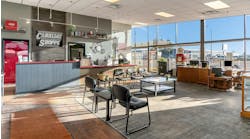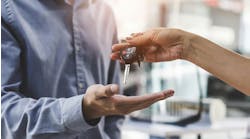Jim Siegfried owns Crystal Lake Automotive, a collision repair and auto service shop in Minnesota’s Twin Cities metro area. He runs it with business partner Karl Drotning. One of them seems to be at the 24,000-square-foot, 26-employee shop at all times. Siegfried says family comes first, but business is a big part of his family.
The way I see it, we don’t just fix cars. We help people. Anyone can fix cars. I love dealing with people. We like to say we treat customers like employees, and employees like family.
I usually start my workday around 9 a.m. I’m not a morning person at all. My business partner, Karl Drotning, takes the early shift. When I get up in the morning, the first thing I do is check my smartphone. I live and die by my smartphone. It charges on my clock radio. Before I even get up in the morning, I unplug my phone and see who texted me overnight. I let people know they can reach me 24 hours a day. I’ve answered phone calls at 1 a.m.
My morning routine is pretty dull—I shower, shave and eat breakfast. On my way to work, I multitask. For example, I’m in a 20 group, and we recently had to read a book before our next meeting. I got the audiobook and listened to parts of it on my drive in. I also take care of some calls and emails. My Google calendar tells me what’s in store for the day. I have a bad memory. But it’s only a problem if you don’t know you have a bad memory.
Some days I pick up Doris, an 84-year-old in Lakeville. I used to work with her husband. When he passed away, we started helping her out by taking her shopping, getting her hair done and stopping at the bank. Friends and family make owning a business worthwhile. You have to take care of them.
Sometimes I get texts asking me to pick up a customer. We’ve picked up customers and brought them home since day one. Karl or I will pick them up and it’s a great opportunity to get to know customers. We’ll ask them how it’s going, what they’re getting done, and how good of a job we’re doing. It’s a great way to get feedback and to get to know our customers.
We drive from as far as 15 miles away. Between Karl and I, we probably give away four to seven rides a day. We just started doing it, and it stuck. Superior customer service is key, and if you don’t do it, you’re in trouble.
We’re not always perfect, though. We get to hear from customers who have had problems with their repair. You can make a mistake, and your customers will forgive you, but you have to find a way to fix the mistake. People really appreciate it.
When I get to work, I usually spend the first 20 minutes checking in with management staff, or anyone who makes decisions. I like to spend time with them, and ask them about everything from what’s going on to how their weekend was. You have to know your staff and really care. We want our employees to work here because it’s a great environment. Over a third of them have been here for 15 years or longer, and another third have been here 10 years or longer.
The place usually runs by itself, and nine out of 10 days no problems need addressing by the time I get to the shop. I learned in our 20 Group that the business should be able to run without Karl or I. We have to have the freedom to be able to grow our business.
Karl and I usually talk in the morning, and we plan out our day. Then we talk throughout the day about different things that come up, whether it’s a customer that needs a ride home, or if he wants to bounce ideas off of me. He frequently travels to and from Wisconsin, where he helps out his aunt who has Alzheimer’s. He’ll call me when he’s thinking about the business behind the windshield.
We opened in 1986, and I joined in 1998. Karl and I both worked at Lehman’s Garage, another Twin Cities-area body shop. He worked in the collision side as a body shop manager, and I worked in mechanical.
We’re completely different, but it works. He likes to look at the shop operations and see how things are going at the shop. I’m at the front, estimating and dealing with technology, and making sure things are running as expected. The way we approach things is different. Partnerships can be very difficult, but we’ve only had one major disagreement. That was when we were designing a new building and disagreed about where to place the oil reel. We flipped a coin to settle the argument. I like to say he’s my work wife.
Later in the morning I load my emails. I don’t like emails. They’re very good, a lot of people like them. My wife can type out a whole page. I usually write one or two sentences. I would rather just say it because email can be taken so many different ways.
In the afternoon I work on projects. Any kind of project. For example, our waiting room needed redesigning. We put $20,000 into restoring the area to make it welcoming and comfortable. Nothing too fancy. Customers wouldn’t take it very well if we installed chandeliers. We bought new furniture, put in a coffee bar, and that type of thing. We made sure it was pleasing to the eye, and not sterile, but warm. I do photography as one of my hobbies, so we have some pictures of northern Minnesota. We also have some auto artwork, and pictures of our community involvement like a Kids Against Hunger event.
Our goal for 2012 is to update our processes for estimating and blueprinting, so that’s another thing I’ve been working on. And in June we’re having our 20 Group come here for a shop tour. Everyone will walk through, look for waste, things to improve, or point out what works and why. Afterward we’ll go back to our hotel to talk about the shop tour, the pros and cons of what they saw, and share other ideas. I’m very excited for them to come. There is always something people suggest, like having a refrigerator up front with water for customers, or more high-quality coffee for customers. Little things make a big difference.
I recommend 20 Groups to anyone who wants to grow their business. We’ve been a part of one for eight years, and it has made a big difference. Every shop in our group has to turn in a monthly report by the fifth of each month. There’s no hiding the numbers, you can’t be afraid to show them. We look at every microscopic detail, from gross profit on labor to percentage on labor versus parts. We tear apart everything to find out where we’re at.
At night the shop closes at 5:30 p.m., and I usually get home around 6 p.m. Karl or I are usually the last two people there. We have people who make sure everything is closed down, but we check on things like making sure all the cars are brought in. We also do our own snow plowing so that the place is shoveled and clean for customers in the morning.
One of the most important things is having an understanding wife. My wife knows the business is always there. When I get home at night, she’ll ask how my day was and how things are at the shop. Sometimes if there’s an issue, like a computer problem, I’ll have to take care of it. This was a lot harder with young kids. But now that my daughter is 26 and my son is 23, it’s a lot easier.
Sometimes other projects need to be done, like research, or meeting up with interviewees or other people after hours. But generally I have dinner with my wife. Three times per week I take up running. I hate to exercise, but my cholesterol and blood pressure were getting high. I couldn’t run a quarter-mile before, but now I can do three miles in under 32 minutes. It helps clear the mind and relax. I can bond with both my daughter and son, who each run. At the shop, we also run; we’ve built a course and some people from the shop—technicians and front office workers—have run it. Some people walk it.
At night I sometimes will get texts as late as 11 p.m. or 11:30 p.m., which drives my wife crazy a lot of times. Our computer guy has young kids and likes to work late. Family comes first, but at the same time, the business is part of the family. It’s a 24-hour commitment.




